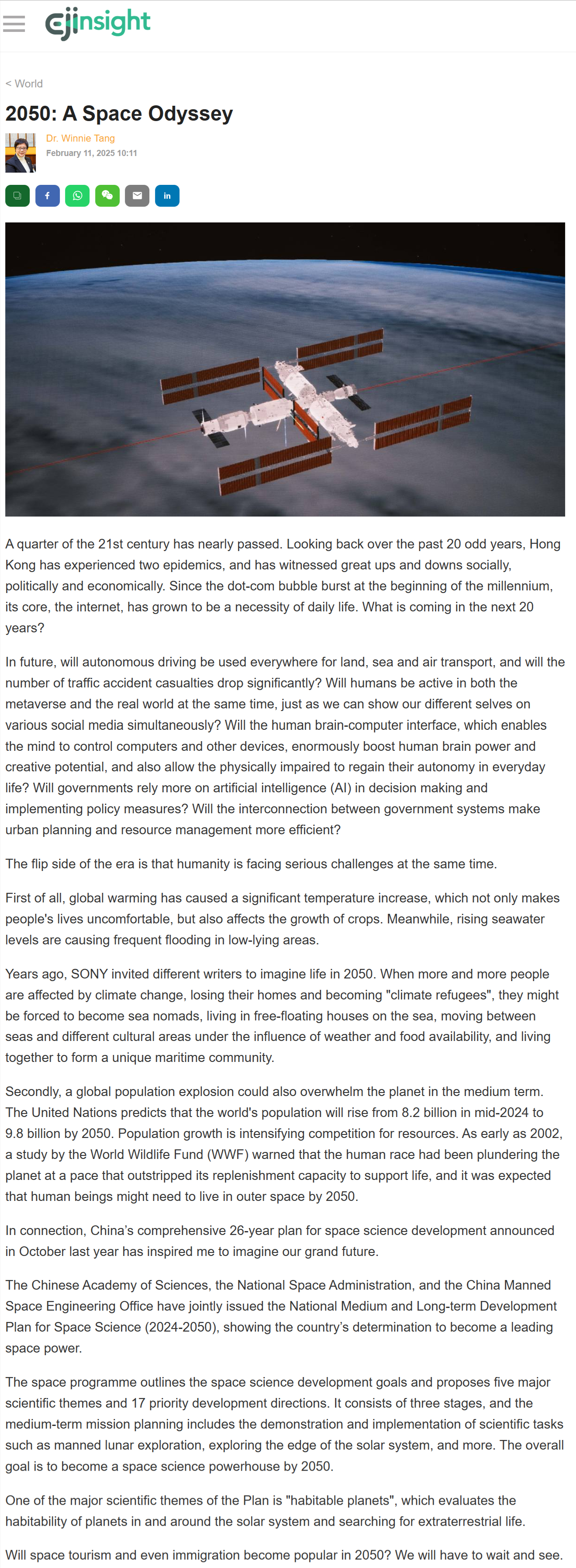網上版請按此

2050: A Space Odyssey
A quarter of the 21st century has nearly passed. Looking back over the past 20 odd years, Hong Kong has experienced two epidemics, and has witnessed great ups and downs socially, politically and economically. Since the dot-com bubble burst at the beginning of the millennium, its core, the internet, has grown to be a necessity of daily life. What is coming in the next 20 years?
In future, will autonomous driving be used everywhere for land, sea and air transport, and will the number of traffic accident casualties drop significantly? Will humans be active in both the metaverse and the real world at the same time, just as we can show our different selves on various social media simultaneously? Will the human brain-computer interface, which enables the mind to control computers and other devices, enormously boost human brain power and creative potential, and also allow the physically impaired to regain their autonomy in everyday life? Will governments rely more on artificial intelligence (AI) in decision making and implementing policy measures? Will the interconnection between government systems make urban planning and resource management more efficient?
The flip side of the era is that humanity is facing serious challenges at the same time.
First of all, global warming has caused a significant temperature increase, which not only makes people's lives uncomfortable, but also affects the growth of crops. Meanwhile, rising seawater levels are causing frequent flooding in low-lying areas.
Years ago, SONY invited different writers to imagine life in 2050. When more and more people are affected by climate change, losing their homes and becoming "climate refugees", they might be forced to become sea nomads, living in free-floating houses on the sea, moving between seas and different cultural areas under the influence of weather and food availability, and living together to form a unique maritime community.
Secondly, a global population explosion could also overwhelm the planet in the medium term. The United Nations predicts that the world's population will rise from 8.2 billion in mid-2024 to 9.8 billion by 2050. Population growth is intensifying competition for resources. As early as 2002, a study by the World Wildlife Fund (WWF) warned that the human race had been plundering the planet at a pace that outstripped its replenishment capacity to support life, and it was expected that human beings might need to live in outer space by 2050.
In connection, China's comprehensive 26-year plan for space science development announced in October last year has inspired me to imagine our grand future.
The Chinese Academy of Sciences, the National Space Administration, and the China Manned Space Engineering Office have jointly issued the National Medium and Long-term Development Plan for Space Science (2024-2050), showing the country's determination to become a leading space power.
The space programme outlines the space science development goals and proposes five major scientific themes and 17 priority development directions. It consists of three stages, and the medium-term mission planning includes the demonstration and implementation of scientific tasks such as manned lunar exploration, exploring the edge of the solar system, and more. The overall goal is to become a space science powerhouse by 2050.
One of the major scientific themes of the Plan is "habitable planets", which evaluates the habitability of planets in and around the solar system and searching for extraterrestrial life.
Will space tourism and even immigration become popular in 2050? We will have to wait and see.
Dr Winnie Tang
Adjunct Professor, School of Computing and Data Science; Department of Geography, Faculty of Social Sciences, The University of Hong Kong